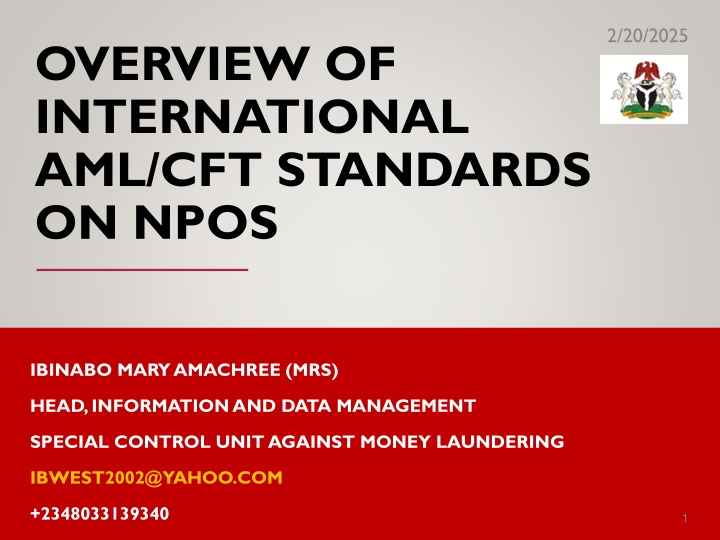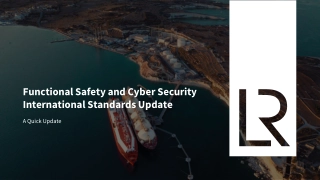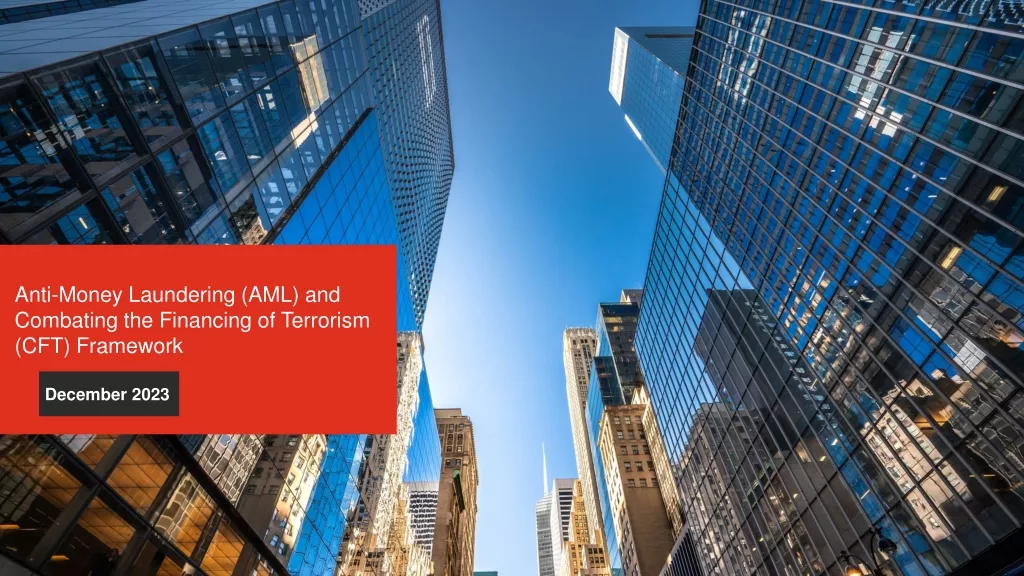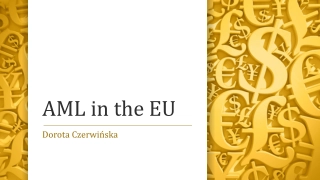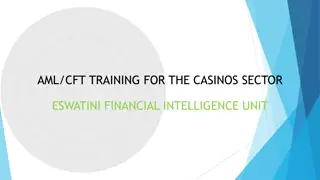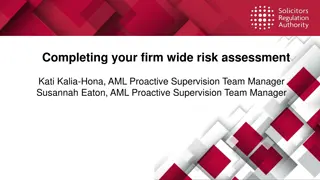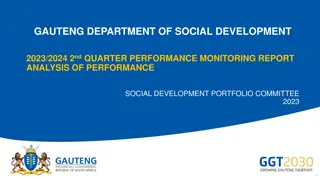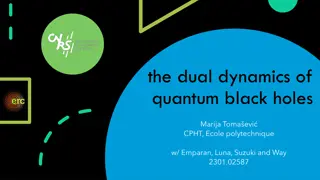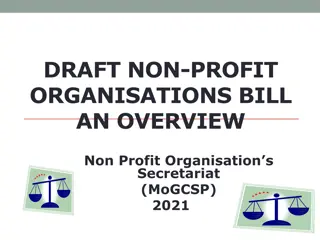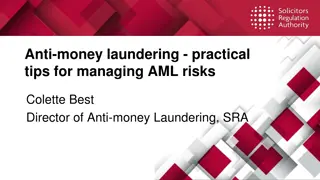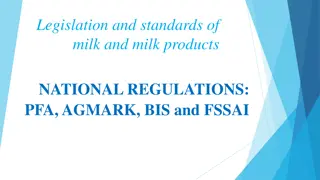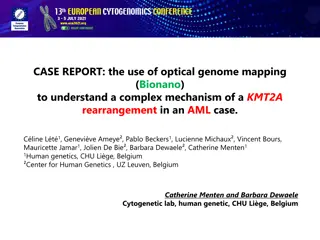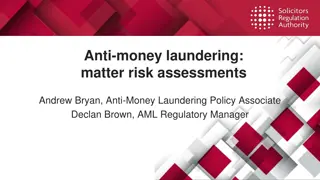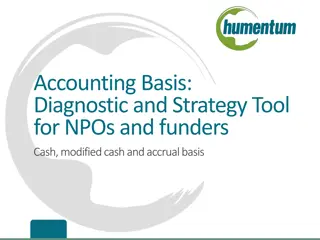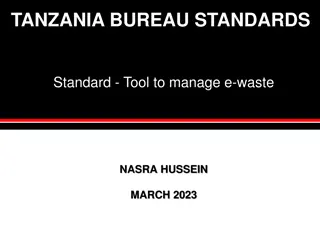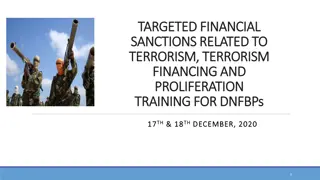International Standards on NPOs: AML/CFT Overview
This overview delves into the international standards governing Non-Profit Organizations (NPOs) with a focus on Anti-Money Laundering/Countering the Financing of Terrorism (AML/CFT) measures. It covers definitions, types of NPOs, FATF and UN standards, as well as case studies and best practices to combat potential abuse of NPOs.
Download Presentation

Please find below an Image/Link to download the presentation.
The content on the website is provided AS IS for your information and personal use only. It may not be sold, licensed, or shared on other websites without obtaining consent from the author.If you encounter any issues during the download, it is possible that the publisher has removed the file from their server.
You are allowed to download the files provided on this website for personal or commercial use, subject to the condition that they are used lawfully. All files are the property of their respective owners.
The content on the website is provided AS IS for your information and personal use only. It may not be sold, licensed, or shared on other websites without obtaining consent from the author.
E N D
Presentation Transcript
2/20/2025 OVERVIEW OF INTERNATIONAL AML/CFT STANDARDS ON NPOS IBINABO MARY AMACHREE (MRS) HEAD, INFORMATION AND DATA MANAGEMENT SPECIAL CONTROL UNIT AGAINST MONEY LAUNDERING IBWEST2002@YAHOO.COM +2348033139340 1
2/20/2025 OUTLINE Definition Types of NPOs The FATF standards on NPOs The UN standards on NPOs The UNSCRs 1267,1373,2255 and 2396 The FATF Best Practice Papers on Combating abuse of NPOs-Guidance and Examples of good practices for Countries. 2 Case Studies
DEFINITION 2/20/2025 NPOis a legal person or arrangement or organization that primarily engages in raising or disbursing funds for purposes such as charitable, religious, cultural, educational, social or fraternal purposes, or for the carrying out of other types of goodworks .(FATF 2012) NPO operation can be categorized into the following five broad activities: Collection of resources Retention of resources Transfer of resources Expenditure of resources Delivery of programs Note: Resources include gift-in-kind and non-financial resources that hold value (properties) A typical NPO is characterized by the following: Extended logistical networks 3 Large transitory workforce Operational capacity; and Organizational culture
TYPES OF NPOS 2/20/2025 Service Based NPO Provision of services that involves some public or collective character such as; Health Education Personal social Cultural Expressive-Based NPO Vehicle for individual and group self-expression called value guardian role citizen participation Leadership development Protection of interest of social, religious, cultural or other minority groups Assisting to liberate individual and allow him/her the fullest possible measure of expression of personal capacities and potentials within an otherwise constraining social environment ..(Smith,1973) The above activities and features makes NPOs to be vulnerable to ML/TF risks, hence need to apply the international AML/CFT measures-FATF standards. 4
2/20/2025 INTERNATIONAL STANDARDS The NPOs activities are regulated by two major international bodies: FATF United Nations (Conventions/Resolutions) 5
2/20/2025 OVERVIEW OF THE FATF STANDARDS The FATF Recommendations set out a comprehensive and consistent framework of measures which countries should implement in order to combat money laundering and terrorist financing as well as the financing of proliferation of weapons of mass destructions(FATF 2012). The measures consist of a set of Recommendations and interpretative(explanatory) notes. 6
2/20/2025 IMPERATIVES OF THE FATF STANDARDS A set of measures that countries and/or jurisdictions should deploy to fight ML/TF Helps countries to prioritise and allocate resources to AML/CFT stakeholders Used to assess the level of compliance (performance) of each country using uniform set of criteria and methodology taking into consideration environmental peculiarities Specify the type of institutions/agencies and their roles, responsibilities and powers and how they are to cooperate Specify expected results from each action taken by the various institutions/agencies Consist of 40 Recommendations and interpretive notes and 11 immediate outcomes 7
2/20/2025 THE 40 RECOMMENDATIONS 8
2/20/2025 THE 40 RECOMMENDATIONS 9
FATF Recommendation 2/20/2025 UN Conventions/Resolutions 1990 FATF 40 Recommendation -Drug money The Vienna Convention 1988-aimed at trafficking in illicit and psychotropic substances and laundering the proceeds thereof. 1996 FATF Recommendation -Beyond drug money (other ML Trends & Patterns) The Palermo Convention 2000-to criminalize money laundering and include ALL serious crimes as predicate offences. 2001 FATF Recommendation included TF, Terrorism (40+9) The UNSCR 1267 Committee was established pursuant to resolution 1267 (2000). It is also known as the AlQaida and Taliban Sanctions Committee. 10
UN Conventions/Resolutions FATF Recommendation 2/20/2025 UNSCR 1373(2001) 2012-the Recommendations were revised again, incorporating the Nine Special Recommendations on Terrorist Financing into the 40 Recommendations Refer to designating individuals and entities related to terrorism and terrorist financing in national level. Accordingly, Institutions are obliged to have measures in place to identify and freeze funds, financial assets or economic resources of such designated persons and entities upon order by the Competent Authority UNSCR 2255(2015) Reaffirms the asset freeze, travel ban and Creation of a Recommendation on assessing risks and applying a RBA Creation of a Recommendation for targeted financial sanctions related to the proliferation of weapons of mass destruction Inclusion of tax crimes within the scope of designated categories of offenses for money laundering arms embargo on individuals, groups, entities associated with the Taliban. More attention on domestic politically exposed persons (PEPs) and those entrusted with a prominent function by an international organization. UNSCR 2396 (2017) Focus on measures to address returning and relocating foreign terrorist fighters(FTFs) and transnational terrorist groups. Strengthen border security, information sharing; passenger Name Record(PNR),Advanced passenger information(API),biometrics etc. Strengthen member states cooperation with the private sector to protect public space and soft target.
2/20/2025 UNSCR 1267 The UNSC 1267 Committee was established pursuant to resolution 1267 (1999). It is also known as the AlQaida and Taliban Sanctions Committee. It was established for the purpose of overseeing the implementation of sanctions measures imposed on Taliban-controlled Afghanistan for its support of Osama bin Laden. If an individual or terrorist organisation is included in this list, it helps in restricting their movement, financial penalties and assets freeze among others. 12
UNSCR 1267 2/20/2025 Require countries to immediately freeze funds, financial assets or economic resources of individuals and entities who are designated by the United Nations Security Council based on such person s / entity s connections with terrorism and terrorist financing. Further, countries should ensure that no funds, financial assets or economic resources are made available to or for the benefit of such designated persons or entities or their beneficiaries. Accordingly, Institutions such as Banks, DNFBPs(NPOs), Stock Brokers and Insurance Companies are obliged to have measures in place to identify and freeze funds, financial assets or economic resources of such designated persons and entities immediately. Freezing is effective as and when the United Nations Security Council announces the names of such designated persons and entities and such freezing shall be in force until such time the person or entity is delisted from the designated list. 13
2/20/2025 UNSCR 1373 (2001) Refer to designating individuals and entities related to terrorism and terrorist financing in national level. Accordingly, Institutions are obliged to have measures in place to identify and freeze funds, financial assets or economic resources of such designated persons and entities upon order by the Competent Authority. 14
PROSCRIBED TERRORIST GROUPS There are 3 main terrorist groups that are proscribed by the Federal Government of Nigeria with powers drawn from the Terrorism (Prevention) (Proscription Order) Notice, 2013 made pursuant to the Terrorism (Prevention) Act, 2011 (as amended). 1. Jama atu Ahlus-Sunnah Lidda awati Wal Jihad (Boko Haram) Jama tul Ahlus Sunnah Lidda a Wati Wal Jihad (a.k.a Ahlis-Sunnah Jama a and Nigeria Taliban) came into existence as an association of Muslim youths under the leadership of Mohammed YUSUF (late) at Indimi Mosque along Damboa Road, Maiduguri, Borno State in the year 2000. 2. Jama atu Ansarul Mislimina Fibiladis Sudan (JAMBS) This group is a breakaway faction of the Jama atu Ahlis-Sunnah Lidda a Wati Wal Jihad (Boko Haram) formed by aggrieved members. The Arabic name means, Vanguard for protecting Muslims in Black African Countries . 15 3. IPOB-Indigenous people of Biafra - September,2017
2/20/2025 FOCUS ON RECOMMENDATION 8 The objective of Recommendation 8 is to ensure that NPOs are not abused by: Terrorist organizations posing as legitimate entities Exploiting legitimate entities as conduits for terrorist financing Concealing or obscuring the clandestine diversion of funds intended for legitimate purposes to terrorist organizations. FATF recommends that NPOs: Maintain and be able to present full program budgets that account for all expenses. Conduct independent internal audits and external field audits, the latter to ensure funds are being used for intended purposes. FATF recommends that charities use formal bank accounts to store and transfer funds so that they are subject to the bank s regulations and controls. In turn, the banks where the accounts are established can treat NPOs like other customers, apply their know-your-customer rules and report suspicious activities. 16
2/20/2025 Recommendation 8 is designed to address the significant gaps identified in the MERs during last mutual evaluation cycle. The implementation of the requirements of R8 is expected to be consistent with the requirements of other FATF Recommendations (R1, R4, R6,) and elements of Recommendations (14, 16, 30, 31, 32, 37, 38 and 40). Also Recs 24 and 25. In particular, R8 is to be implemented based on the over-arching requirements of R1 involving: Understanding of risk Mitigating the Risk In the next round of ME, compliance with requirements of R8 is the understanding of domestic NPO sector and the terrorist financing risks it faces. Sectoral review at the entire domestic NPO sector is fundamental; Application of Risk-Based Approach is the foundation for countries to determine how best to mitigate TF risk. 17 The effectiveness of implementation of R8 will be assessed in Immediate Outcome 10 (IO:10) Terrorists and terrorist organizations are prevented from raising, moving, and using money, and not permitted to abuse non-profit organizations (NPOs).
REQUIREMENTS OF R8 2/20/2025 Countries should undertake programmes to raise awareness in the NPO sector about vulnerabilities of NPOs to TF and Terrorist abuse. How Regular dialogue with NPO for better collaboration. Engaging with NPO associations,coalitions,S ROs, Donor organizations Identify which part of government should be focal point(SCUML) Outreach to Sector Countries should take steps to promote effective supervision or monitoring of NPO sector. Apply proportionate and dissuasive sanctions. Apply know your beneficiary and associate NPOs -confirm identity, credentials of beneficiaries and associate NPOs. How Purpose and objectives of activities, Identify BO, Issue annual financial statement showing breakdown of income and expenditure. Application of proportionate and flexible supervisory regimes to avoid over-regulation. Supervision or Monitoring of NPO Sector Ensure cooperation ,coordination and information sharing on NPO. Ensure lines of reporting for TF related issues. How Inter-agency collaboration Effective investigation and information gathering in the NPO Sector Identify points of contact for RFI in respect of NPO to TF Information from foreign counterparts is key in identifying and taking action against TF threats. Effective Capacity to Respond to Int l RFI on NPO 18
MITIGATING THE RISK OF TERRORIST ABUSE OF THE NPO SECTOR R8 recommends the following in designing mitigating measures to the NPO sector; 2/20/2025 Measures should not deliberately or otherwise restrict the ability of NPO to access resources that are required to carry out their legitimate charitable activities. The measures should promote transparency and engender greater confidence in the sector, across the donor community and with the general public that charitable funds and services are reaching their intended legitimate beneficiaries. Measure should promote respect for and observance of fundamental human rights and freedom (expression, religion, belief, and peaceful assembly and association) Deployment of a diverse range of approaches in identifying, preventing and combating terrorist misuse of NPOs. Need to implement mitigation measures that are commensurate (i.e. proportionate) with the risks identified thereby avoiding CFT regulatory measures that disproportionately affect or burden NPOs with little or no TF risk. Measures should not be one-size-fit-all but flexible, adaptable, scalable, and multifaceted using a proportionate RBA involving the following four elements 19
MITIGATING THE RISK OF TERRORIST ABUSE OF THE NPO SECTOR - CONT D Measures should not be one-size-fit-all but flexible ,adaptable, scalable, multi-faceted using a proportionate RBA involving the four element below: 2/20/2025 1. Outreach to sector 2. 2.Supervision and monitoring 3. 3.Effective investigation and information gathering 4. 4.Effective capacity to respond to international request. 20
COMPONENT OF MER ASSESSMENT 2/20/2025 Technical Compliance Effectiveness ratings There are no short comings High level of effectiveness The immediate outcome is achieved to a very large extent. Minor improvement is needed Compliant (C) Largely Compliant(LC) There are only minor short comings Substantial Level of effectiveness The immediate outcome is achieved to a large extent. Moderate improvements needed. Partially Compliant (PC) There are moderate short comings Moderate level of effectiveness The immediate outcome is achieved to some extent. Major improvements needed. Non Compliant (NC) There are major short comings Not Applicable (NA) A requirement does not apply, due to structural,l legal or institutional features of a country. Low level of effectiveness The immediate outcome is not achieved or achieved to a negligible extent. Fundamental improvement needed. 21
2/20/2025 THE FATF ELEVEN IMMEDIATE OUTCOMES 22
CASE STUDY: NON PROFIT ORGANIZATION. TRADE BASED TERRORIST FINANCING 2/20/2025 This case was initiated by an STR submitted by a bank to the Niger FIU. Cash was deposited into the account held by an NPO, then immediately transferred or withdrawn. The subsequent investigation revealed the NPO received USD 6 million in illicit transactions over a two year period from two affiliated religious associations based in Europe. The two main directors of the NPO were originally from a country in the Middle East and the NPO listed well drilling (for water) and general trade as its main activities. A number of information exchanges between FIUs (including three European FIUs) revealed that the head of one of the religious associations had previously been accused of tax evasion and donation fraud. That same religious association had also been registered on the list of dangerous movements in a European country. To facilitate the illicit transactions, the directors of the NPO created a shell Import Export company in Niger. The Import-Export company director was European, but had originated from the same country as the directors. More than 80 per cent of the funds received by the NPO were transferred to accounts belonging to the shell company, as payment for services provided. However, information received from customs revealed the company had never imported/exported anything, despite numerous financial transactions received from neighbouring countries. Investigations are ongoing 23 Source: Niger FIU
2/20/2025 FUNDING (THROUGH AN NPO) BY ORGANISATIONS LISTED AS SUPPORTERS OF TERRORIST GROUPS 1 A financial institution submitted an STR to the Cameroon FIU with respect to the financial transactions of Mr Z. Mr Z was a resident of Foumban in western Cameroon and did not have any formally declared sources of income. The suspicious transaction was a transfer of CFA 124 million (approximately EUR189000) deposited into the personal bank account of Mr Z in July 2015 from an agency in a Gulf country. No valid economic or legal reason was provided for the transaction. The FIU s investigations revealed Mr Z temporarily resided in the same Gulf country for a number of years and had worked at the headquarters of a designated terrorist organisation. Mr Z was the promoter of NPO X, the headquarters of which was listed as Foumban, Cameroon. However, the competent administrative authority was not aware of NPO X s activities. Between 2012 and 2014, in a bank account opened under its name, NPO X received various transfers from a designated terrorist organisation. This organisation was listed by the UN and the US Department of State as a financial supporter of terrorist groups worldwide and domiciled in the same Gulf country. Source: Cameroun FIU 24
2/20/2025 FUNDING (THROUGH AN NPO) BY ORGANISATIONS LISTED AS SUPPORTERS OF TERRORIST GROUPS 2 Between 2012 and 2015, NPO X received, approximately CFAF 423 million (EUR644,818) from the designated terrorist organisation. During the same period, approximately CFA 547 million (EUR833,842) was transferred to NPO X and Mr Z s accounts. Authorities had not recorded any activity by NPO X in Foumban, Cameroon. Instead, the funds had been systematically transferred to Kousseri bank branches (in the extreme north of Cameroon close to Chad and Cameroon borders). Exchanges between the FIU and operational intelligence services revealed it was likely that Mr Z came into contact several times with individuals close to the logistics and arms provider of BH Mr Z was arrested by security services and investigations are underway to identify the entire network Source: Cameroun FIU 25
CASE STUDIES: FT TYPOLOGIES IN NIGERIA TF through charities and levies International NGO/Charity ZT with HQ in the Middle East; Links to terrorism discovered at CDD procedure FIU STR: - transactions inconsistent with the profiles of its accounts - frequent cash deposits and withdrawals, including those from domestic ATMs, by individuals with no apparent connection to the charity and mostly in areas with a high incidence of terrorist activity within Nigeria; ZT claimed them to be paying the salaries of itinerant Islamic clerics in Nigeria - transfers of funds from ZT s accounts into the accounts of individuals with whom ZT had no apparent relationship - cash deposits structured and made through multiple branches of the same bank - funds transfers from a foreign jurisdiction by a national of a country known to be state sponsor of terrorism - series of transfers into the accounts by the charities headquarters in the Middle East. Source: FATF/GIABA 2013 TF Report
OCTOBER 2010 BOMBING On the morning of October 1st 2010,. An attack was carried out by the Movement for the Emancipation of the Niger Delta (MEND) near Eagle Square. HHH, a Nigerian residing in South Africa was alleged to have planned and funded the attacks from South Africa. He was able to achieve this with the help of his brother, CCC and three of his friends. HHH is a known factional leader of MEND The car bombs had been rigged up in Port Harcourt, the main city in the oil producing Niger Delta, before being driven to the capital City where they were detonated near the Independence Day parade at the Eagle square. On investigation, the Nigerian security agency (PGT) was able to unravel the following principal actors in the saga. Residence owner (Mr. A) where vehicles used in the bombings were wired in city X Purchaser of vehicles (Mr. B) Coordinator of attacks (Mr. C) along with HHH. Coordinator of vehicle movement (Mr. D) to Abuja Suspect (Mr. E) who confirmed the operation had been a success after the blasts.
OCTOBER 2010 BOMBING NFIU therefore revealed details of financial transactions, linked accounts, associates, entities and other individual transaction through an NGO (ABC) account operated by HHH. The association of HHH to ABC and other entities that were suspected to be involved in coordinating the funds movement for the attack became evident when request for additional information was made by the NFIU on the related Financial Institutions. Analysis showed that HHH provided the finance through his NGO (ABC) in order for these bomb explosions to take place as investigation linked the purchase of the explosives and payment for the construction of hidden compartments in the two vehicles used for the attack to the monies paid to Mr. B in the sum of N1.2M ($7,500) and N2M ($12,500) respectively. Associates were also used to transport physical cash and make cash deposits in small amounts of N700,000, N250,000, & N1m etc into bank accounts of other individuals who assisted in the purchase of materials (dynamite). It is interesting to note that, where payment was made through an account, most of the withdrawals were made through the ATM.
OCTOBER 2010 BOMBING Investigation further revealed that HHH was also involved in Illicit arms trafficking often imported into Nigeria by ships. It was further revealed that he supplied arms to his associates to the tune of N22.5M ($140,625) who later delivered to different parties on his behalf. These are facts judicially acknowledged in the judgment against HHH. Investigation further uncovered that HHH and his associates raised funds through kidnapping as confessed during interrogation. Four expatriate executives were kidnapped after an attack by MEND on Oil Company s terminal in a Local Government city X. N135 million was received as ransom for their release.
2/20/2025 REFERENCES FATF Recommendation 2012 FATF Methodology for assessing technical compliance with the FATF recommendations and the effectiveness of AML/CFT systems 2013. Study Guide CAMS Certificate Examination 6th Edition Terrorist Financing typology Nigeria report 2013 Terrorist Financing in West And central Africa 2016 30
